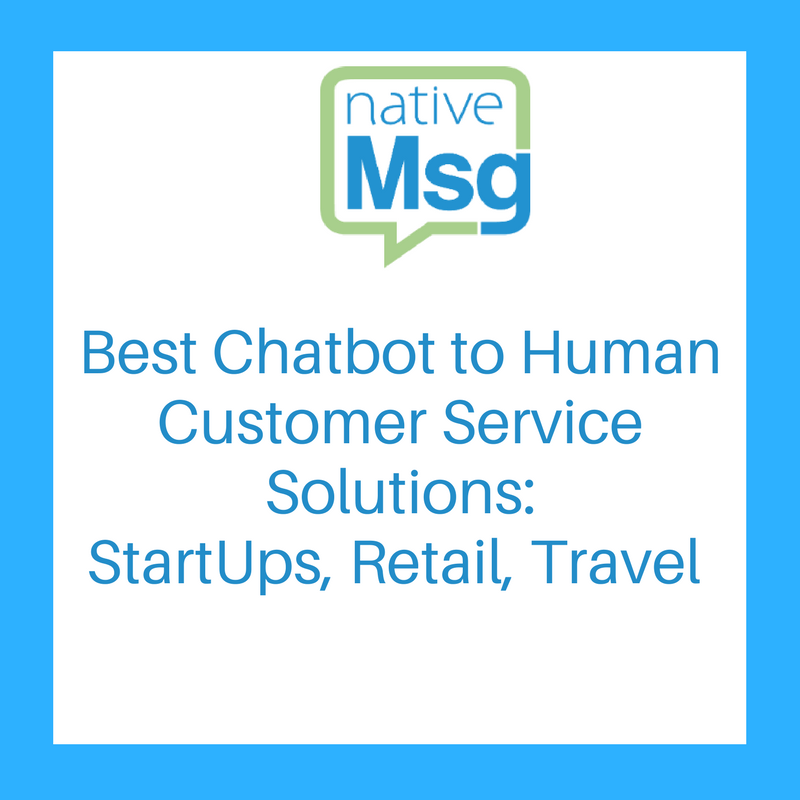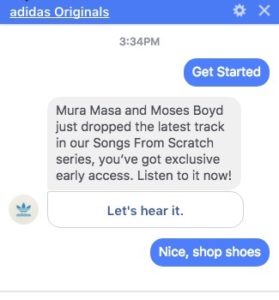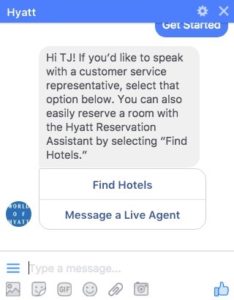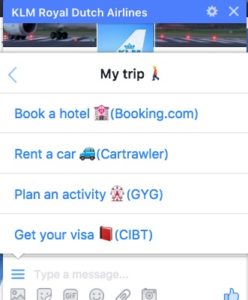
By now, startups to enterprise businesses are aware customer engagement and deeper personalization are crucial to sustaining a competitive edge to be successful. Research shows that in markets where chatbots exist, 45% of users prefer chatbots as the main format in customer service. Retail trends show chatbot for website solutions searches have increased and chatbot development for every industry, from retail chatbots to hospitality and travel chatbots have made headlines.
One of the most consistent questions chatbot platforms receive is what is the best chatbot/human hybrid customer service strategy––and how can we get started?
It’s clear you want to incorporate this technology; most business have some customer engagement plan designated within their budget in the coming year. Likewise, many businesses want to start with a blended structure, to reap the dual benefits of both chatbot and live human customer care.
That makes the most sense given the benefits for both below:

The problem lies in how to effectively include a chatbot that, really, needs to maintain the same level of customer service and oversight as a live agent. Many organizations are unclear how and where to get started on including a chatbot into their customer service structure.
For All Industries:
Start with the Most Engaged Channel to Grow into Blended Channel Solutions
Most importantly, the future isn’t across channels, but in a blend of channels as customer-centric centralized, simplified access. You and your consumers are at the beginning of a new digital experience as Messaging as a Platform is the new blended channel and Messaging as an Application is the new store front.
In a recent piece on Forbes, one AI-company CMO notes:
Rather than adding more channels, companies will begin to orchestrate the customer experience by pairing channels to make a consumer’s experience easier.
Companies will do a better job of choreographing a consumer’s experience within and across channel pairs, such as chatbot to live chat. I’ll take it a step further and say it won’t be just pairing. Pairing is the start. There may be three or four channels that blend together.
In most cases, your organization looks something like this-
Most Common Customer Support Structure (Across Industries)
A traditional customer support structure includes 2 to 4 positions.
For a startup, or small to medium-sized business, no matter the industry, you’re likely starting with a manager and customer service rep team. For enterprise businesses, you have a designated customer service department with an organizational structure that includes:
Management– This position is a liaison between company-wide initiatives and goals, and department-wide execution for quality-control at every level.
Supervisor– A supervisor or lead can be interchangeable and one-in-the-same for smaller businesses. But if your organization runs several customer support centers or segments by product, service and marketing support needs, you probably have a hierarchal system including supervisors per department and team leads within departments.
Lead- A lead can handle day-to-day communication and internal operations within an organization. They’re the first point of contact for service agent goals, queries and for some organizations, for escalations. Again, the mode of communication can vary as some organizations track via service tickets or have a more internalized structure for routing service requests, needs and complaints.
Service Agent- These are the most customer-facing employees in your business, whether via phone calls, emails, live-chat or IM, customer service agent skills need to be of a high-level and training.
Take into consideration the added customer service tasks of personalized messages to mark birthdays, surveys, service feedback and a customer service rep team can be overwhelmed at the customer-facing, top-of-funnel tasks to maintain engagement and customer satisfaction.
START-UP HYBRID SOLUTIONS:
Trade-out Escalation Tickets for Messaging and Better Tracking
Unfortunately, most businesses will fail within the first five years. That’s a well-known statistic. Startups face an overwhelming task of creating verticals while managing daily operations with limited human capital––in many cases.
Your customers simply want to reach you, easily. Funnel your contact in one flow to the channel your customers most engage on currently. Twitter has seen upwards of a 200% engagement in the last few years, and B2B businesses see higher loyalty in responsive social here, as well as along other channels. Direct customer inquiries to an automated chatbot via a channel like Twitter from all possible contact points. Switch out fix-it tickets or inquiry tickets for a chatbot so you’re continuing to delight your customers with fast responsiveness.
How Your Startup Can Do This:
Poor Jo customer is having trouble setting up your software for his company. He really doesn’t have time to hang on the phone, or send a long message. He just wants answers.
You: Your start-up’s built a consistent CTA across all channels that says something along the lines of: Quick Response Assist.
Jo: Clicks and your chatbot allows him to leave a voice message, send a video or send a snapshot of his problem–whichever ways is quickest. It also shows how to do each of these things, in a quick one minute video, first.
Jo: sends a video of what happens when he walks through and your chatbot responds, instantly, that not only is he in a cue, but that the chatbot will offer accurate answer now to solve the problem. Jo doesn’t have to wait, he gets his answer. He also gets a follow-up call from customer service that’s deeply personalized based on the interaction within a day. He knows you care. He got a fast answer. Awesome service. And now your developer who has been doing double-duty in growth-hacking is off the hook and can continue making cool stuff.
RETAIL HYBRID SOLUTIONS:
Automate Returns and General Inquiries
Integrate a Hybrid Solution for In-Depth Product Information Service
Here’s the good news for every retail organization reading this: Large, name- brand retailers, from big brand clothing retailers, to sporting goods, still don’t have this worked out very well. How do we know? Because we’ve tested name-brand retailers’ messaging channels for customer service inquiries and responsiveness and we’ve found the responsiveness to be inconsistent.
Athletic shoe companies, that are typically Millennial and Z-Generation focused, are doing well at incorporating chatbots for service and experience.

How Your Retail Business Can Do This:
Whether good or bad, it’s a low bar for retailers to jump right now, and that bar’s set to responsiveness. Keep it instantly responsive, for any and all reasons, and you’re going to have a happier customer.
Customer JoAnne: She’s frustrated that it’s taking forever to get a response…from a chatbot, or any “live person.” Consumers feel frustrated when a platform they vaguely understand to be the most responsive just isn’t.
You: Automating a hand-off has to include the following:
- Timing of when JoAnne can expect to reach a live agent
- Customer experience engagement in the interim (think of this as a grand replacement to the elevator music of past days,) JoAnne can opt to watch short, interesting videos, check-out new music, see news about the product and so forth.
TRAVEL HYBRID SOLUTIONS:
Completely Automate Bookings
Offer a Hybrid Structure for All Escalations
The travel industry, by far, has some of the best hybrid chatbot-to-customer service agent experiences.

Whether a boutique hotel, travel service, concierge or airline, customer service via a chatbot is easy to automate for all booking in a more efficient way than online booking currently allow. Messaging is fast and simple.
However, a hybrid solutions works best for:
- Flight cancellations
- Loss of property or misplaced luggage
- Delays
- Poor experience
KLM has a great customer experience structure for its customer service via chatbots on Facebook Messenger.

At the start, you can set-up a trip. But where you need help a live agent is responsive in the channel along the pathway of booking, in this case.
In many cases, companies opt for a “Get Started” button to begin a conversation (within Facebook Messenger). KLM keeps its channel open, so you can ask to start, or speak with a live agent right away.
How Your Travel or Hospitality Business and Service Can Do This:
Customer Jose: Jose is stuck in an airport, flights canceled and wants to know when (when, when) he’ll for sure be on a new flight and what he should do for the time being.
You: Your hybrid chatbot takes down Jose’s information and offers the following:
-Guaranteed next available flight with one click
-15 minute updates with customer experience engagement and the option to adjust notification timings
-Available accommodations in the area with one click booking
For Jose, hand-off to human service can occur with service agents at the desk who have received Jose’s information and queries and can alert him, by messaging, to come to the desk for a scheduled appointment.
Can chatbots really do all this across platforms?
Yes.
It’s a case of simple hand-off alerts in the escalation process.
But, how to do so with your structure? Easily:
-Set-up a “Speak to Live Agent” button throughout the experience and set-up a queue alert so your customer knows exactly how much time it will be until they speak.
-Set-up alerts via real-time screen notifications to your agents, that originate from the chatbot platform. It’s really that easy; your employees need limited training to come up to speed on the technology.
Now roles can look more like this––and quell any employee concerns that their customer service position is going anywhere, as it stand to be the most important one in the customer experience:
Top-Down-
Customer-Service Agent- Premiere role in customer-facing service. This role actively steps in when a notification is pinged and responds directly and personally on a chatbot platform.
Lead- The service lead can view the analytics data retrieved by these hybrid interactions. They can gather crucial data on queries, complaints, timing and demographics to hand-off to management. They can also respond to escalations and personalize these without a consumer needing to restate the issue or awaiting a hand-off for a better experience.
Management-Now, management is free to use the data in this hybrid structure to present to the organization for increased innovation, and better customer experience.
Yes, there are more complexities here, such as setting up re-routing systems and queue-times and notifications. Keep in mind, this functionality is already in existence for phone and chat service. Working with an expert team that first understands your service structure and then where to place a chatbot in that flow, is essential to this update.
If you’re considering how to add a chatbot into your customer service flow, it’s simple to start by automating general, common questions to free-up live customer support for more complex interactions and transactions.
You can check-out how to create an effective conversational layer for your business by starting here and get in touch with our team to help answer any questions.
Free Trial
Get Started With RCS
Business Messaging!
Unlock the power of RCS and revolutionize your customer engagement.



